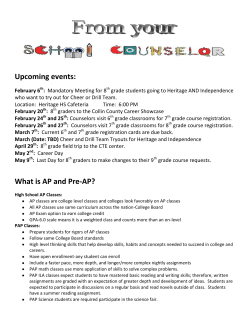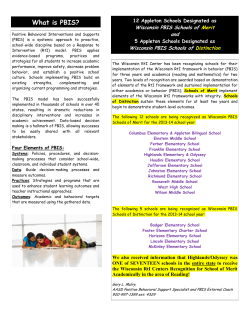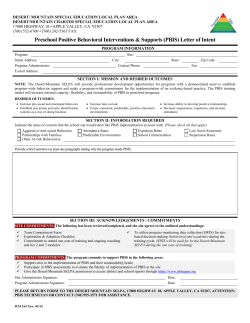
“A Community Passionate About Student Success”
“A Community Passionate About Student Success” What is Galileo? If you’ve heard students, teachers, or principals talking about Galileo and its results you may have this question. Galileo is a third-party assessment system that is being used across the district in grades K-8 to regularly assess student progress in reading, math, writing, and science as well as evaluate “teacher effectiveness” in core subjects. Benchmarks are given three times a year to track student progress and, as of this year, pre and post tests are being given to students in core content areas to evaluate how well a teacher is teaching his/her subject. Results of each test are being analyzed on a regular basis by classroom teachers, school administrators, intervention specialist, and district staff to determine instructional needs in the classroom and to guide focused re-teaching and interventions for students who need additional support to meet grade level standards. Galileo estimates that 70% of all Arizona districts are now using their assessment system to improve student achievement. Galileo’s large sample size of data, as well as their banks of valid and reliable question items allow for a “predictive” analysis of student performance. Teachers are able to see how students will likely perform on end of the year tests such as AIMS and make adjustments in their instruction to increase student success. While this is only predictive data, Galileo has been quite accurate in their predictions and their test results frequently align with results of the Dynamic Indicator of Basic Early Literacy Skills (DIBELS) tests as well as classroom assessments. A district wide focus in recent years has been in improving math instruction. Mid year results of AIMS benchmarks indicate that we are on track to have more students pass the AIMS test in math than we did last year in all grade levels to be tested! Ask your child’s teacher for more information on how your children are performing in Galileo. Curriculum Connection FY12-13 Volume 2 Bales Elementary School currently has 10 faculty members who have been trained in the Bell-to-Bell engagement strategies of instruction, as facilitated by Sara Buckerfield. Overall, the instructors have benefited from the experience. Mrs. Chaney, 6th grade math, states “My student interaction has greatly increased through the use of permanent partners. The feedback has been beneficial.” Ms. Picaso, 7th grade language arts, said “It’s always great to hear from an outside source that I am on track with my teaching...I’ve learned a lot.” Mr. Pieroni, 7th grade math, commented “The addition of introductions and closings to my every day lessons has proved extremely beneficial in my students’ learning.” Ms. Thornberry, 8th grade math, said “Giving students more talk time and less teacher talk time was a great suggestion. My students have definitely benefited from this, as have I.” Mrs. Brickell, 7th and 8th grade science, uses an exit procedure called “Feed the Dog”. All student work is fed to the dog where the teacher collects it, scores it and then returns it. In this way the teacher isn’t directly handed student work which can be misplaced. Inca Elementary School has eight teachers in the 6th, 7th and 8th grades that had the opportunity to be trained in “Bell-toBell” strategies, be observed and offered feedback. The 7th Grade Team of Christine Parks, Ken Vallier and Cliff Hymel commented, “’Bell-to-Bell’ allows for more time on task and allows us to be consistent as a grade level.” T.J. Klein and Mary Davis, 6th Grade teachers, said, “We benefitted greatly from our training. For example, the ‘Clinics’ helped to positively focus our classroom management to change behavior. The introduction of permanent partners (Chips and Salsa) provided an added element to the classroom experience.” The 8th Grade Team of Gail Oxford, Justin Dennis and Amanda Decker agreed that, “This training provides great, effective strategies that are easy to implement into any classroom; no matter how long we’ve taught. We think that the strategies have helped our students excel.” Page 2 Buckeye Elementary School has twelve new and experienced teachers benefiting from the Bell-to-Bell training by being sound in their strategies and routines and gaining additional classroom instruction time to teach the standards and learning objectives for the day. Mrs. Kathy Kusnetzow, 7th Grade Math, says “This has helped me with my class by showing me different ways to use start and call back signals. I believe that all new teachers need this training to get a good start during the school year.” Mrs. Wendy Sparkman, 6th Grade, states “The training has added to and confirmed some of my skills, learned the hard way, when I taught 7th grade math. The permanent partner check before answering the teacher helps my students feel more confident to answer. This confirms and continues to support my class rules of having a safe and educational environment.” Mrs. Jane Ricci, 8th Grade Language Arts, comments “I have incorporated the vocabulary portion of the training with complete success. I feel as though my students are learning and using the new vocabulary with ease. This has enhanced my teaching practices.” Jasinski Elementary School has implemented “Bell-to-Bell” strategies with much enthusiasm. Ten teachers were able to attend at least one training; many have attended more. We are also fortunate to have Sara Buckerfield come onto our campus monthly and coach the teachers who have been trained. There has been great success in classrooms when it comes to entry and exit procedures, heightening student engagement and maximizing instructional time. Rob Wehofer, 6th Grade, states, “After attending the training, I realized that there were strategies I was already using. I just had to tweak them or add a few more and the results were astonishing. The students are engaged more actively.” Ashley Hult, 7th Grade, responded, “This training has been a positive addition to my classroom because the strategies provide me with routines that are both easily implemented and have successful outcomes. The program encouraged me to develop both entry and exit routines to ensure class begins and ends swiftly; with students engaged every moment they are in the classroom.” Curriculum Connection FY12-13 Volume 2 As a school the implementation of Bell-to-Bell is evident in the overall impact on more time to use for instruction in the classroom. This picture is the strategy called “Ticket Out The Door” where the students post their responses as they leave the classroom. The following are a few quotes regarding the use of the new strategies: My entire year has changed drasti- cally with the implementation of these strategies. It has created a more positive learning environment and the students are engaged in learning and having a great time doing it.— Ashley Brannon, 6th Grade Science The best concept I have used is the permanent partners, assigning partners to discuss one at a time forces more participation by EVERYONE and does not allow for one talker to take over. I can assess groups/ individuals that are not getting the lesson.—Kim Sears, 7th Grade Language Arts I’ve started timing my lectures and using an engagement strategy every five minutes...I teach/ You teach; I teach, I question, You answer; I teach/You teach the slide.—Brandi Garner-Svensson, 8th Grade Math I’ve implemented a lot of the strategies and have noticed that the students attention is better, their tasks are completed efficiently and my overall classroom management and timing is better.—Jessica Farkash, 6th Grade Language Arts I have implemented slowing down to ensure that all students are actively having time to process.—Craig Stengel, 7th Grade Math Page 3 “Bell-to-Bell” has transformed the 6th-8th grade classes at WestPark. Teachers were challenged to change their perspective on instruction, procedures, transitions, student engagement and classroom management. Here are comments in picture order… Ms. Hatt, 7th/8th Math, said “The most powerful aspects I have added to my classroom are the permanent partner and the creative callback.” Mr. Bauer, 6th Grade, explained “It has made me more aware of how I conduct my day to day tasks in the classroom and has helped me to teach students to be more responsible for their own learning.” Mrs. Davis, 6th Grade, states “It has helped my students improve their vocabulary tremendously. They are more attentive since I started using the ‘Come Back To Me’ phrase to keep them on task.” Mrs. Nelson, 6th Grade, shared “These strategies have changed the dynamic in my classroom. My favorite tool to use is ‘tracking’ where I can easily grab the students’ attention whenever I need them.” Mrs. Distelhorst, 7th/8th Language Arts, commented “The use of permanent partners maintains direction, retention of instruction, and creates teachers out of each student.” Mrs. Holtsclaw, Music, reported “These strategies have really helped me use my class time as efficiently and effectively as possible.” TIPS for PARENTS To help students who are in need of a little extra support of math instruction at home... Math in the Car: Identify license plate numbers Math in the Kitchen: Math in the Store: 1:1 correspondence—how many plates, forks, Identify things that come in groups, i.e., a cups do we need to set the table. dozen eggs, a pair of socks, six-pack of soda, Sequencing or find numbers in order hot dogs vs. buns Measurement: Have children help with (patterning), i.e., street addresses, license Larger and smaller plates, street numbers recipes; how many servings and how large are they? Ways to combine the numbers they see, Estimate number of items on a shelf or Nutrition labels +, -, x, / display Find groups of things in order, i.e., one pole, Older students can actually cook by following Weigh produce and estimate cost two legs on the sign, 3 lights on a stoplight, 4 a recipe; have them create the shopping list Keep track of cost and estimate total (don’t wheels on a car, etc. and estimate the cost. forget tax for older students) Miles per hour Change a recipe; halve or double it Which item is a better value? Time and distance: How long would it take us to get to Grandma’s house traveling at _____mph? What happens if we go faster? Slower? Freeway vs. surface streets? Miles per gallon: How much gas would we need to get from Buckeye to Phoenix and home, and how much would it cost (based on current gas prices)? Time: How long will it take to cook? What time will it be when we are finished? If it takes 10 minutes to cook the vegetables and 30 minutes to prepare the main dish, what time should you start the veggies to be sure they are ready and hot at the same time the rest of the meal is ready? Weight for little ones: Which can is heavier, lighter, or more, less? Discounts (% off on sales) Coupons; how much was saved? What’s the price now” Is it still a better buy? Expect More Arizona: http://www.expectmorearizona.org/resources/parents/parentmaterials/ Arizona Department of Education Common Core Information for Families: http://www.azed.gov/azcommoncore/families/ http://www.azed.gov/azcommoncore/families/familiestoolbox/parentsguide/ Shifts for Students and Parents (Engage NY): http://engageny.org/sites/default/files/resource/attachments/shifts-for-students-and-parents.pdf Khan Academy: https://www.khanacademy.org/ For More Information: Contact the District Math Specialist, Tessa Herrington, at therrington@besd.k12.az.us or 623-925-3400 Curriculum Connection FY12-13 Volume 2 Improving student academic and behavior outcomes is about ensuring all students have access to the most effective and accurately implemented instructional and behavioral practices and interventions possible. This school year, district staff is receiving training in Positive Behavior Intervention and Support (PBIS) that is being provided by the Arizona Department of Education. BESD school psychologists, building counselors, the district’s special education director and two school principals are participating in the year-long training. The individuals participating have created a district team that will provide training and coaching in PBIS to other district staff as well as create an action plan that will guide district efforts to implement PBIS in schools. The team also includes Jasinski Elementary and Inca Elementary staff representatives and principals who are creating a plan for implementing PBIS in their schools during the 2013-14 school year. Through a State Department grant, the district and school teams will have an opportunity to have two additional years of training supported by the State department as long as requirements of the grant are met. PBIS provides a systematic approach to teaching and recognizing appropriate behavior in schools. Goals for the effective implementation are to reduce behavioral incidents and eliminate lost instructional time due to the need to intervene in students’ negative behavioral incidents. Creating a positive school climate through explicit instruction of positive behavior is also a goal of the system. Teaching and reinforcing expectations is achieved by establishing clear rules Upcoming Events... March 26th: 2013 Math Challenge: District Math Challenge will be held at the BESD Central Office. Each school site will send a 3rd/4th Team, a 5th/6th Team and a 7th/8th Team. Top team of each grade grouping will go on to attend the Westside Impact Spring Math Challenge in May, 2013. May 10th/11th: Westside Impact Science Fair to be at Pendergast Learning Center, 3841 N 91st Avenue, Phoenix, AZ Page 4 and routines and using reinforcement procedures. The PBIS teams agreed to have consistent rules district wide which are: Be Safe, Be Respectful, Be Responsible and Be Kind! Members of the district and building teams are now analyzing the discipline data from this year to determine a baseline; when PBIS is implemented at Inca and Jasinski the two schools will analyze their discipline data monthly to determine next steps for instruction. In addition, school-wide expectations will be developed by the staff focused on the rules selected by the district teams. Below is an example from another PBIS school of what school-classroom expectations might look like: School-wide Expectations Be Respectful C L A S S R O O M Be Responsible Be Cooperative Raise your hand Bring Paper, pen- Do what your and wait for permis- cil and books to teacher asks sion to speak or class immediately leave your seat R U Keep hands, feet L and objects to yourE self S Start work immediately, work during work times Turn completed assignments in on time 85037 (91st Avenue and Indian School). Project drop off Friday between 3:30 pm and 5:00 pm with judging starting at 5:30 pm. Viewing and pick-up will be from 10:00 am until 2:00 pm on Saturday. June/July: 2013 Summer School tentatively planned to be at three sites; Buckeye Elementary, Inca Elementary and Sundance Elementary schools. It will run Monday through Friday from 8:00 am until 1:00 pm. Breakfast, Lunch and Trans– portation to be provided. More details to come! A Note From Dr. Sandvik… I want to take this opportunity to thank parents and staff for continued support. Your commitment to a strong partnership with our schools helps ensure that we are a community passionate about student success! We are working extra hard this spring to help our children in 2nd grade advance their reading skills by providing after school tutoring three days a week at each of our schools. Parents can help their children by reading at home, listening while their children read aloud, visiting libraries, providing books, and asking children about books they are reading at school. Again, thank you for your continued support and partnership with our schools. 2013 Summer Camp at BESD PRESCHOOL Ages 3—12 June 3—June 27 July 8—July 26 Register Now Call 623-925-3333 for more information
© Copyright 2025





















